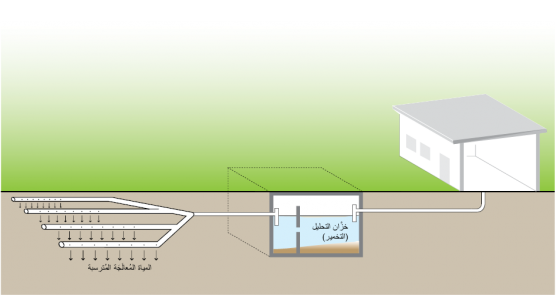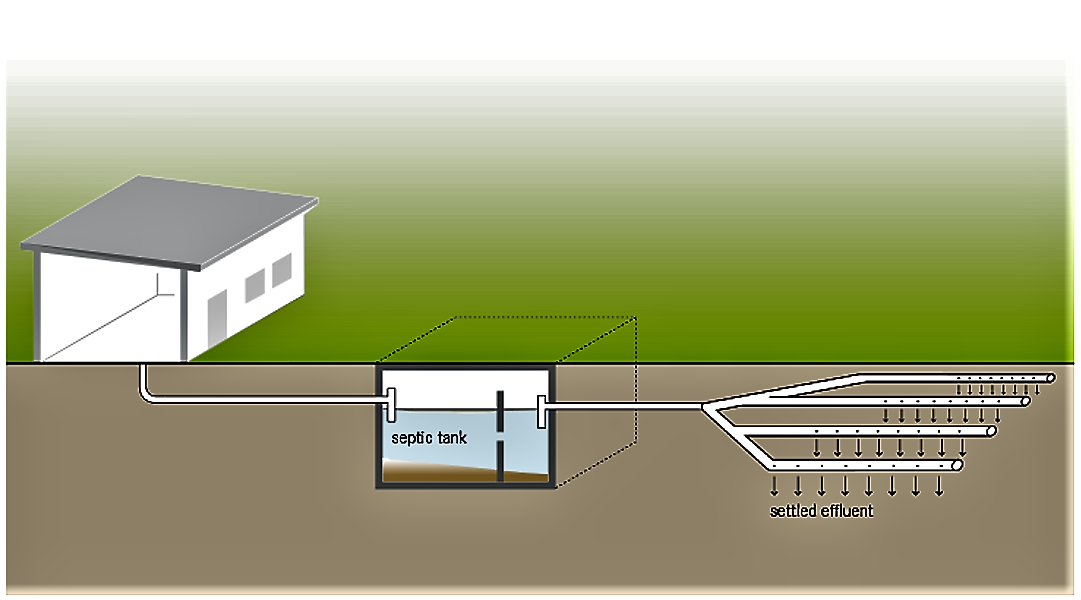المُلخص التنفيذي
حقل التصريف الشبكي Leach Field أو ما يُسمي بحقل الصرف Drainage Field، هو عبارة عن شبكة من الأنابيب المُثقبة، يتم وضعها في خنادق مليئة بالحصى تحت الأرض، لتقوم بتسريب التدفقات السائلة الخارجة من تقنيات الجمع والتخزين/المُعالجة أو المُعالجة (شبه) المركزية
يتم ضخ التدفقات السائلة الخارجة التي تم ترسيب محتوياتها سابقًا إلى نظام الأنابيب (المتكون من صندوق التوزيع والعديد من القنوات المتوازية) الذي يقوم بتوزيع التدفقات تحت سطح التربة لامتصاصها ومعالجتها لاحقًا. يمكن تركيب نظام للتوزيع بالضغط أو بالجرعات؛ من أجل ضمان استخدام طول حقل التصريف بالكامل، وأنه يسمح بإعادة تهيئة الظروف الهوائية بين الجرعات. ويقوم نظام التوزيع بالجرعات بضخ التدفقات السائلة الخارجة في حقل التصريف على فترات زمنية مضبوطة بجهاز توقيت (غالبًا تكون ثلاث أو أربع مرات في اليوم الواحد).
| المُدخلات | المُخرَجات |
|---|---|
التدفقات السائلة الخارجة |
- |

Introduction
Pre-settled effluent is fed into a piping system (distribution box and several parallel channels) that distributes the flow into the subsurface soil for absorption and subsequent treatment. A dosing or pressurized distribution system may be installed to ensure that the whole length of the leach field is utilized and that aerobic conditions are allowed to recover between dosings. Such a dosing system releases the pressurized effluent into the leach field with a timer (usually 3 to 4 times a day).

اعتبارات التصميم
يتم حفر كل خندق بعمق يتراوح ما بين 0.3 إلى 1.5 متر وبعرض يتراوح ما بين 0.3 إلى 1 متر. ويجب أن يتم ملء قاع كل خندق بحوالي 15 سنتيمترًا من الصخور الصغيرة النظيفة )الجرش(، ثم تُوضع عليها الأنابيب المُثقبة، ويتم وضع المزيد من الصخور لتغطية تلك الأنابيب. كما يتم وضع طبقة مُكونة من نسيج التكسية الأرضية Geotextile فوق طبقة الصخور من أجل منع الجسيمات الصغيرة من سد الأنابيب. وأخيرًا تُوضع طبقة من الرمال و/أو التربة السطحية لتغطي نسيج التكسية الأرضية، وتُملأ الخنادق حتى مستوى سطح الأرض. ويجب وضع المواسير على بعد 15 سنتيمترًا تحت سطح الأرض من أجل منع مياه الصرف من أن تطفو على السطح.
كما يجب مراعاة حفر الخنادق بطول لا يزيد عن 20 مترًا وألا تزيد المسافة بين الخنادق عن متر أو مترين على الأكثر. ومن أجل منع التلوث يجب أن يتم بناء حقل التصريف على بعد 30 مترًا على الأقل من أي مصدر لمياه الشرب. كما يجب بناء حقل التصريف بشكل لا يمكن له أن يتعارض مع أي شبكات للصرف الصحي قد يتم بِناؤها في المستقبل. وينبغي أن تكون تقنية الجمع التي تَسبق حقل التصريف الشبكي على سبيل المثال، خزان التحليل والتخمير مُجهزة بوصلة مع شبكة الصرف الصحي؛ وذلك إذا ما قضت الحاجة إلى تغيير مكان حقل التصريف الشبكي فيما بعد فيتم ذلك التغيير بأقل قدر من المشاكل.
الجوانب الصحية / القبول
بما أن هذه التقنية تتواجد تحت الأرض وتتطلب القليل من العناية، فنادرًا ما يتعامل المستخدمون مع التدفقات السائلة الخارجة، وبالتالي فليس لها أي مخاطر صحية. يجب أن يتم إبعاد حقل التصريف الشبكي قدر الإمكان )على الأقل 30 مترًا( عن أي مصدر محتمل للمياه الصالحة للشرب؛ من أجل تفادي تلويثها.
التشغيل والصيانة
يُمكن أن يحدث انسداد في حقل التصريف الشبكي مع مرور الوقت، على الرغم من أن هذا قد يحدث بعد 20 عاماً أو أكثر إذا كانت هناك تقنية جيدة للمُعالجة الأولية ويتم صيانتها بشكل جيد. ولكي يعمل حقل التصريف الشبكي بطريقة فعَّالة، يجب إجراء بعض أعمال الصيانة البسيطة؛ ولكن في حالة توقف النظام عن العمل بكفاءة، فيجب تنظيف الأنابيب أو إزالتها وتبديلها بأنابيب أخرى جديدة. ومن أجل الحفاظ على حقل التصريف الشبكي يجب تجنب أي نباتات أو أشجار فوقه، كما يجب ألا يكون هناك حركة مرور كثيفة فوقه من أجل تفادي انكسار الأنابيب أو ضغط التربة.
المياه ،الصرف الصحي النظافة الصحية وظروف الإقامة في السجون
التلوث : المخاطر والحلول
بناء الحمامات وطرق تحسينها وصيانتها
الصرف الصحي الموقعي والمركزي - للمدن والتجمعات السكانية الصغيرة
Small and Decentralized Wastewater Management Systems
Decentralised wastewater management presents a comprehensive approach to the design of both conventional and innovative systems for the treatment and disposal of wastewater or the reuse of treaded effluent. Smaller treatment plants, which are the concern of most new engineers, are the primary focus of this book.
CRITES, R. TCHOBANOGLOUS, G. (1998): Small and Decentralized Wastewater Management Systems. New York: The McGraw-Hill Companies IncGreywater Management in Low and Middle-Income Countries, Review of Different Treatment Systems for Households or Neighbourhoods
This report compiles international experience in greywater management on household and neighbourhood level in low and middle-income countries. The documented systems, which vary significantly in terms of complexity, performance and costs, range from simple systems for single-house applications (e.g. local infiltration or garden irrigation) to rather complex treatment trains for neighbourhoods (e.g. series of vertical and horizontal-flow planted soil filters).
MOREL, A. DIENER, S. (2006): Greywater Management in Low and Middle-Income Countries, Review of Different Treatment Systems for Households or Neighbourhoods. (= SANDEC Report No. 14/06 ). Duebendorf: Swiss Federal Institute of Aquatic Science (EAWAG), Department of Water and Sanitation in Developing Countries (SANDEC) URL [Accessed: 27.05.2019]Septic Tank and Septic Systems
This paper presents a review on the septic tank and septic systems. Information on design and functional aspects, and environmental effects of septic tank systems are presented.
POLPRASERT, C. RAJPUT, V.S. (1982): Septic Tank and Septic Systems. (= Environmental Sanitation Reviews , 7 ). Bangkok: Environmental Sanitation Information Center URL [Accessed: 08.04.2014]Design Manual - Onsite Wastewater Treatment and Disposal Systems
Rather old design manual for onsite wastewater treatment options. However, valuable information on established systems such as septic tanks, sandfilters, aerobic treatment units (suspendend growth and fixed film), disinfection, nutrient removal as well as wastewater segregation and recycling are given. Additional information is given on disposal methods and appurtenances.
U.S. EPA (1980): Design Manual - Onsite Wastewater Treatment and Disposal Systems. (= EPA 625/1-80-0 ). United States Environmental Protection Agency and Office of Water Office of Research and Development URL [Accessed: 27.05.2019]Compendium of Sanitation Systems and Technologies. 2nd Revised Edition
This compendium gives a systematic overview on different sanitation systems and technologies and describes a wide range of available low-cost sanitation technologies.
TILLEY, E., ULRICH L., LÜTHI, C., REYMOND P. and ZURBRÜGG C. (2014): Compendium of Sanitation Systems and Technologies. 2nd Revised Edition. Duebendorf, Switzerland: Swiss Federal Institute of Aquatic Science and Technology (Eawag) URL [Accessed: 03.05.2023] PDFHomeowner Manual for Septic Tanks and Leach Fields
Compendium of Sanitation Systems and Technologies (Arabic)
This is the Arabic version of the Compendium of Sanitation Systems and Technologies. The Compendium gives a systematic overview on different sanitation systems and technologies and describes a wide range of available low-cost sanitation technologies.
TILLEY, E. ULRICH, L. LUETHI, C. REYMOND, P. SCHERTENLEIB, R. ZURBRUEGG, C. (2014): Compendium of Sanitation Systems and Technologies (Arabic). 2nd Revised Edition. Duebendorf, Switzerland: Swiss Federal Institute of Aquatic Science and Technology (Eawag) PDFA Homeowner's Guide to Septic Systems
This manual provides information on functionality of septic systems containing the modules septic tank and leach field and addresses the user at the household level. Construction, maintenance and operation are described.
IDAHO DEQ (2001): A Homeowner's Guide to Septic Systems. Boise: Idaho Department of Environmental Quality (IDAHO DEQ) URL [Accessed: 04.05.2010]How to Select Appropriate Technical Solutions for Sanitation
The purpose of this guide is to assist local contracting authorities and their partners in identifying those sanitation technologies best suited to the different contexts that exist within their town. The first part of the guide contains a planning process and a set of criteria to be completed; these assist you in characterizing each area of intervention so that you are then in a position to identify the most appropriate technical solutions. The second part of the guide consists of technical factsheets which give a practical overview of the technical and economic characteristics, the operating principle and the pros and cons of the 29 sanitation technology options most commonly used in sub-Saharan Africa.
MONVOIS, J. GABERT, J. FRENOUX, C. GUILLAUME, M. (2010): How to Select Appropriate Technical Solutions for Sanitation. (= Six Methodological Guides for a Water and Sanitation Services' Development Strategy , 4 ). Cotonou and Paris: Partenariat pour le Développement Municipal (PDM) and Programme Solidarité Eau (pS-Eau) URL [Accessed: 19.10.2011]Greywater Management in Low and Middle-Income Countries, Review of Different Treatment Systems for Households or Neighbourhoods
This report compiles international experience in greywater management on household and neighbourhood level in low and middle-income countries. The documented systems, which vary significantly in terms of complexity, performance and costs, range from simple systems for single-house applications (e.g. local infiltration or garden irrigation) to rather complex treatment trains for neighbourhoods (e.g. series of vertical and horizontal-flow planted soil filters).
MOREL, A. DIENER, S. (2006): Greywater Management in Low and Middle-Income Countries, Review of Different Treatment Systems for Households or Neighbourhoods. (= SANDEC Report No. 14/06 ). Duebendorf: Swiss Federal Institute of Aquatic Science (EAWAG), Department of Water and Sanitation in Developing Countries (SANDEC) URL [Accessed: 27.05.2019]Wastewater Systems for New Housing Developments
This document discusses several options for sewage collection and wastewater treatment in new subdivisions and low-cost housing developments.
PHILIPPINE SANITATION ALLIANCE (2008): Wastewater Systems for New Housing Developments. (= Sanitation Technology Information Sheet ). Mindanao: United States Agency for International Development, League of Cities of the Philippines